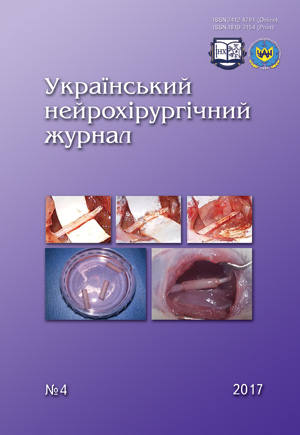Elimination of recurrent post-necrotic skin defect with titanium implant in the left frontal-temporal-parietal brain lobes using combined expansion of tissues while neuro-rehabilitation of a female patient with prolonged post-coma consciousness disorders
DOI:
https://doi.org/10.25305/unj.116683Keywords:
defect of the head soft tissues, necrosis of displaced skin flap, repeated plastic, tissue expansion, syndrome of the trephined, neurorehabilitationAbstract
Elimination of severe syndrome of the treponated with meteorological dependence and drug-resistant symptomatic epilepsy after decompressive hemicraniectomy in patients with severe acute hypoxic brain lesions (vegetative status) is a valid clinical statement for early neurorehabilitation, and an important pre-condition for achieving higher levels of consciousness in terms up to 6 months after patients’ coming out of coma. Skull bones extensive defects substitution with titanium mesh implant requires surgical tactics clear planning and prevention of unlikely complications such as skin necrosis above the implant.
The clinical case of long-term (within 2 years) renewing treatment and neurorehabilitation in a patient in vegetative state caused by brain severe hypoxia after meningioma partial removal in a region of the sella turcica diaphragm and left posterior oblique process is described. Innovative techniques of tissue expansion let us decrease surgical complications, postnecrotic defect of the soft tissue, severity of neurological deficit and to achieve maximum of patient’s consciousness possible recovery.
References
1. Multi-Society Task Force on PVS. Medical aspects of the persistent vegetative state (1). N Engl J Med. 1994 May 26;330(21):1499-508. Review. [CrossRef] [PubMed]
2. Multi-Society Task Force on PVS. Medical aspects of the persistent vegetative state (2). N Engl J Med. 1994 Jun 2;330(22):1572-9. Review. Erratum in: N Engl J Med. 1995 Jul 13;333(2):130. [CrossRef] [PubMed]
3. Kondrat’ev AN, Fadeeva TN, Kondrat’eva EA. Klinicheskie i elektrofiziologicheskie podkhody k diagnostike i terapii bol’nykh v vegetativnom sostoyanii. Anesteziologiya i reanimatologiya. 2003;(4):47-50. Russian.
4. Wilson JT, Pettigrew LE, Teasdale GM. Structured interviews for the Glasgow Outcome Scale and the extended Glasgow Outcome Scale: guidelines for their use. J Neurotrauma. 1998 Aug;15(8):573-85. [CrossRef] [PubMed]
5. Persistent vegetative state: report of the American Neurological Association Committee on Ethical Affairs. ANA Committee on Ethical Affairs. Ann Neurol. 1993 Apr;33(4):386-90. [CrossRef] [PubMed]
6. Childs NL, Mercer WN, Childs HW. Accuracy of diagnosis of persistent vegetative state. Neurology. 1993 Aug;43(8):1465-7. [CrossRef] [PubMed]
7. Pfeiffer E. A short portable mental status questionnaire for the assessment of organic brain deficit in elderly patients. J Am Geriatr Soc. 1975 Oct;23(10):433-41. [CrossRef] [PubMed]
8. Practice parameters: assessment and management of patients in the persistent vegetative state (summary statement). The Quality Standards Subcommittee of the American Academy of Neurology. Neurology. 1995 May;45(5):1015-8. [CrossRef] [PubMed]
9. Laureys S, Berrй J, Goldman S. Cerebral Function in Coma, Vegetative State, Minimally Conscious State, Locked-in Syndrome, and Brain Death. Yearbook of Intensive Care and Emergency Medicine 2001. Springer Berlin Heidelberg; 2001;386–96. [CrossRef]
10. Zaitsev OS, Tsarenko SV. [Neuroreanimatology. Exit from coma (therapy of post-coma)]. Moscow: Litass; 2012. Russian.
11. Yepifanov VA, Yepifanov AV. [Rehabilitation in Neurology]. Moscow: GEOTAR-Media; 2015. Russian.
12. Belova AN. [Guidelines in Neurorehabilitation]. Moscow: Antidor; 2002. Russian.
13. Milanov IO, Adamyan RT, Shekhter AB. [Use of fibrin glue to cover microsurgical autografts with a free split skin]. Khirurgiya. Zhurnal imeni N.I. Pirogova. 2004;(12):4-9. Russian.
14. Abramov NA, Zhidkov SA, Kuz’min YuV. [Skin plastic surgery in purulent surgery]. Meditsinskie Novosti. 2000(6):53-6. Russian.
15. Lipatov KV, Komarova EA, Krivikhin DV. Osobennosti autodermoplastiki rasshcheplennym loskutom v gnoynoy khirurgii. Al’manakh klinicheskoy meditsiny. Russian. [eLIBRARY.RU]
16. Khrupkin VI, Lipatov KV, Komarova EA, Asatryan AG, Borodin AV. Plastic Surgery in Patients with Soft-tissue Infection. Vestnik of Experimental and Clinical Surgery. Russian. 2013;6(2):131-139. [eLIBRARY.RU]
17. Blokhin NN. [Skin plastic surgery]. Moscow: Medgiz; 1955. Russian.
18. Vyalov SA, Pshenisnov KP, Kuindoz P, Montandon D, Pitte B. [Modern ideas about the regulation of the wound healing process]. Annaly plasticheskoy, rekonstruktivnoy i esteticheskoy khirurgii. 1999;(1):49-56. Russian.
19. Gostishchev VK, Lipatov KV, Komarova EA, Kho BO, Marakutsa EV. Plastic surgery in patients with soft-tissue infection. Khirurgiya. Zhurnal imeni N.I. Pirogova. 2009;(12):19-24. Russian. [eLIBRARY.RU]
20. Izmailov SG, Izmailov GA. [Purulent-inflammatory and necrotic diseases of the skin and subcutaneous tissue]. Nizhnij Novgorod: ABAK; 1999. Russian.
21 Mikhel’son NM. [Filatov’s stem and its use in reconstructive surgery]. Moscow: Medgiz; 1951. Russian.
22. Parfenov VA. [Spasticity]. In: Orlova OR, Yakhno NN, editors. [The use of botox (botulinum toxin type A) in clinical practice: a guide for physicians]. Moscow: Katalog; 2001. P.108-23. Russian.
23. Chambers HG. The surgical treatment of spasticity. Muscle Nerve Suppl. 1997;6:S121-8. Review. [CrossRef] [PubMed]
Downloads
Published
How to Cite
Issue
Section
License
Copyright (c) 2017 Olexander V. Kulyk, Volodymyr G. Ushakov, Ruslan M. Pidhayetskyy, Oleksandr V. Borzykh, Sergiy Y. Krysko, Arthur O. Mumlev

This work is licensed under a Creative Commons Attribution 4.0 International License.
Ukrainian Neurosurgical Journal abides by the CREATIVE COMMONS copyright rights and permissions for open access journals.
Authors, who are published in this Journal, agree to the following conditions:
1. The authors reserve the right to authorship of the work and pass the first publication right of this work to the Journal under the terms of Creative Commons Attribution License, which allows others to freely distribute the published research with the obligatory reference to the authors of the original work and the first publication of the work in this Journal.
2. The authors have the right to conclude separate supplement agreements that relate to non-exclusive work distribution in the form of which it has been published by the Journal (for example, to upload the work to the online storage of the Journal or publish it as part of a monograph), provided that the reference to the first publication of the work in this Journal is included.









